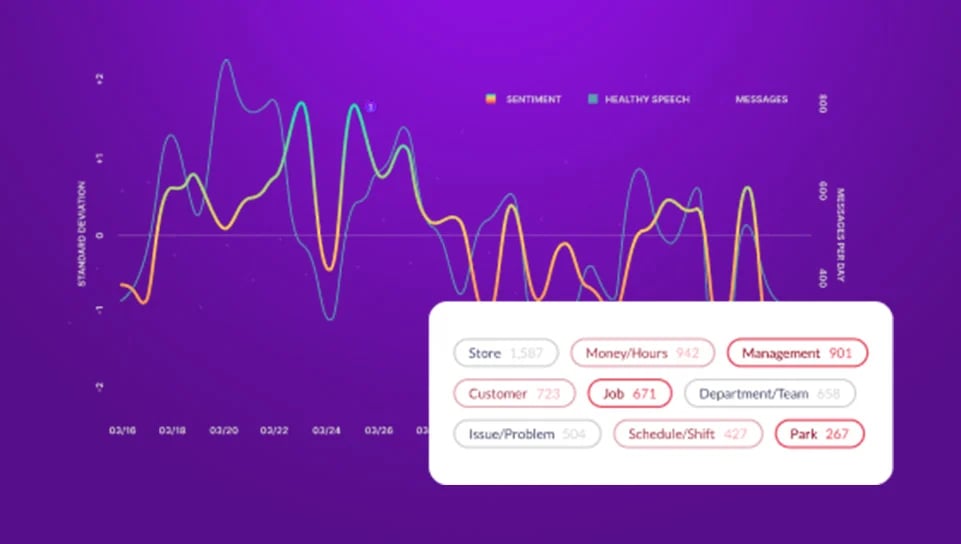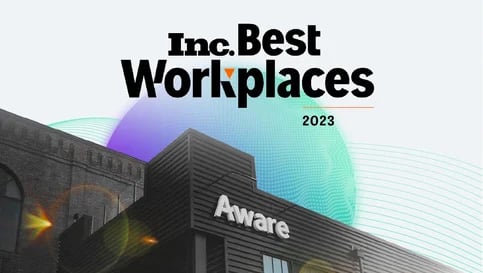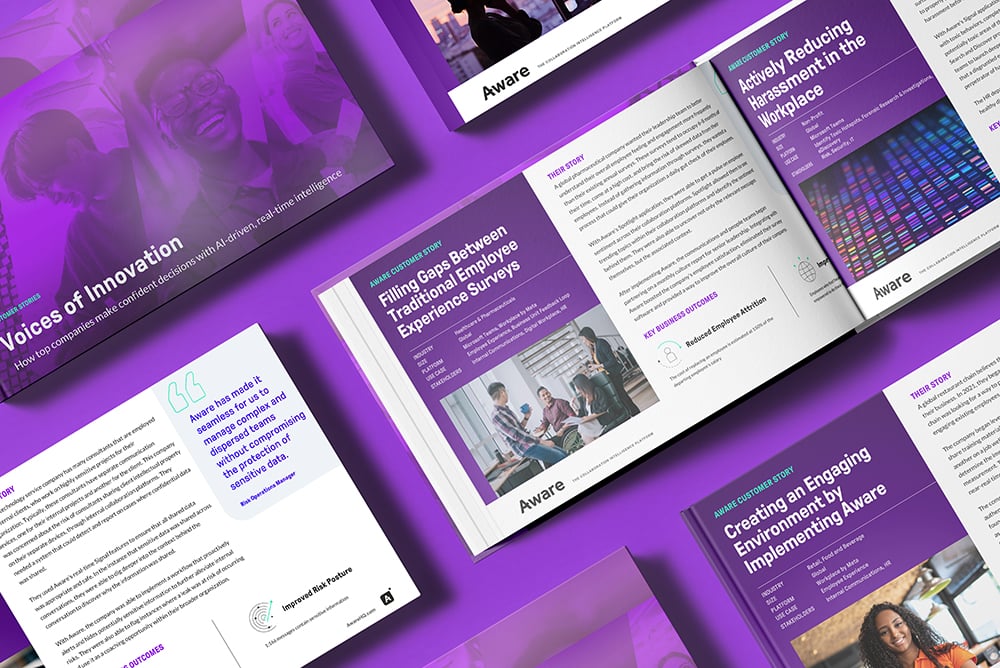PURPOSE-BUILT FOR IT & COLLABORATION OWNERS
Safely and securely roll out collaboration across your organization
Satisfy security, compliance and legal requirements with Aware's integrated solution. Cut through the red tape and administer successful collaboration at scale.
Security
- Data Management & Remediation
- Forensics & Investigations
- Sensitive Data Monitoring & DLP
- Incident Response
Compliance
- Information Governance
- Data Retention
- Compliance Monitoring
- Audits & Investigations
- Acceptable Use Policy Enforcement
Legal
- Collection
- Data Preservation & Legal Holds
- Document Review
- Early Case Assessment
SECURITY + COMPLIANCE + LEGAL
All in one, easy to use SaaS platform

AWARE REVIEWS
Elevating the role of IT
“Aware has broken down the wall that existed between IT and the business. We are now seen as a strategic enabler to the business versus a cost center.”
— Digital Workplace Manager

POWERING PRODUCTIVITY FROM STARTUP TO FORTUNE 100
COMPARE AND SAVE
Administer modern collaboration
from a unified platform
Aware
-
One platform, one workflow
-
DLP at the speed of collaboration
-
Audit-ready compliance tools
-
Native data governance
-
Efficient, contextual eDiscovery
-
Automated content moderation
-
Dedicated support
vs
Multiple Platforms
-
Multiple platforms & workflows
-
Cumbersome endpoint solutions
-
Potential regulatory exposure
-
Costly data maintenance & storage
-
Incomplete evidence collection
-
Manual content review & removal
-
Unreliable products & services
integrations
Streamline your workflow
With the click of a button, Aware leverages native APIs and webhooks to ingest and analyze data from across collaboration channels.
Extend the value of the platform by integrating insights from Aware into your existing workstream with workflow APIs.
FEATURES
Enterprise-ready, designed for collaboration
Give teams across the enterprise peace of mind while optimizing your workflow. Aware’s native functionality allows you satisfy stakeholders and give you the control you need to be successful.
SAML-based SSO
Provides a seamless login experience through a single identify provider authentication process
Responsible AI
Follows the best practice of Responsible AI which produces representative results and performance
RBAC + Data Access Controls
Easily assign roles to users featuring configurable permissions to help keep data and the enterprise secure
Audit Logs
Access and retain user activity history, maintaining complete control of your Aware environment
Encryption
Data encryption in transit, at rest, and in your control
Public APIs
Developer ready APIs for use case workflows and custom data ingestion
SOC 2 Type 2 Certified
Complies with the Trust Services Criteria for managing customer data: security, availability, processing integrity, confidentiality, privacy
ISO27001 Certified
Committed and able to manage risks related to the security of data owned or handled
GDPR/CCPA Compliant
Complies with the EU’s rules for personal data processing and provides tools to help you comply
Latest blog posts
The latest news, technologies, and resources from our team.
Questions? We're here to help
Everything you need to know about the Aware platform.
What collaboration tools does Aware support?
Aware connects natively to all major workplace collaboration tools, including Slack, Microsoft Teams and Viva Engage (formerly Yammer), Zoom Team Chat, Webex by Cisco, Google Drive, and more. Aware also integrates with frontline management and company culture tools such as Workplace from Meta and WorkJam. Using Aware’s Context API, businesses can also bring the power of Aware to any place where their employees collaborate.
What are the risks associated with unmanaged collaboration messages?
Employees rely on company-provided collaboration tools like Slack, Teams and Zoom to help them do their jobs quickly and effectively. Because the tools are sanctioned by the workplace, it’s fair to assume they are safe repositories for all work-related conversations. However, information security and legal leaders know that is not the case. Collaboration tool datasets are stored indefinitely by default, and their complex architecture of public, private and group conversations makes it almost impossible to see all the sensitive information they hold. Aware research shows that just 5000 employees will generate over 30 million collaboration messages each year, and approximately 1:166 of them will contain confidential or protected information or toxic and harassing statements. It only takes one of those messages to become public to cost the company millions in lost market cap, fines and penalties and lawsuits. Companies must proactively manage their collaboration tool data to mitigate the many risks it contains.
What is data loss protection (DLP)?
Data loss protection (DLP) is a term for the tools and practices designed to protect confidential information from unauthorized access or exfiltration. A complete data loss protection strategy involves identifying sensitive data, establishing rules about how that data is handled, and implementing measures to enforce those rules. DLP is important for every business, but especially those in highly regulated industries like the financial sector or healthcare. Some data is legally protected, while other data is proprietary or confidential to the individual enterprise. To be successful at protecting their data, a company must define what sensitive, protected, proprietary or confidential data looks like and where it resides within their messaging ecosystem.
What is compliance adherence for collaboration tools?
Sensitive information such as credit card details, names and address, and confidential company data proliferate across collaboration datasets. This leaves organizations at risk. Compliance adherence is how businesses ensure their internal policies meet legal and regulatory requirements regarding how they handle this sensitive data. Additionally, compliance adherence reviews how employees handle and share data to confirm they follow policy at all times. Successful compliance adherence ensures the enterprise is operating in a responsible and ethical manner and proactively identifies and mitigates risk associated with noncompliance.
What is eDiscovery?
The process of identifying, preserving, and analyzing electronic data to respond to legal or regulatory requests is known as eDiscovery. When required for litigation or investigation, electronically stored information (ESI) must be captured in a format that is defensible and searchable. This data can come from emails, instant messages, social media posts, business documents and more. Because of the volume of data involved in ESI, eDiscovery can be extremely costly to organizations that don’t have solutions in place to make their data accessible.
What damage can a disgruntled employee do in collaboration tools?
Collaboration tools open up new opportunities for toxic or disgruntled employees to disrupt or even sabotage the organization. Because collaboration tools can sync messages and files in real time across multiple devices, they make it much easier to exfiltrate information. All a disgruntled employee needs to do is send themselves a sensitive file in a collaboration message, sync that message through their phone or personal computer, save the file and delete the message. If organizations do not deploy a platform like Aware that ingests collaboration messages in real time, that entire transaction can go undetected.
Are collaboration messages private? Can third parties see company collaboration chats?
The privacy of collaboration messages depends on how they are sent and stored, and what settings or third-party applications the workspace owners implement. In general, direct message conversations between two users are private and can only be seen by those users. However, messages sent in public channels or private groups can be seen by all members of that channel or group. If a company collaboration tool allows external vendors to be added to channels or groups, that third party can also view all the messages they contain. Additionally, workspace owners and administrators can gain access to all the content in their collaboration tools, including messages, files, and other data. Employees should follow company policies governing the appropriate use of collaboration tools and use best judgment when sharing or uploading information within collaboration conversations.
How does Aware automate search and investigations?
Aware ingests collaboration data from tools like Slack, Teams, and Zoom in real time into its intelligent data fabric. There, messages are normalized, analyzed, and infused with AI insights that reveal the full context while ensuring no details are lost. Legacy data management systems lack this functionality because, unlike Aware, they weren’t built for the nuances of collaboration. Normalizing data from multiple sources enables Aware to conduct automated federated search and investigations with forensic precision from all sources simultaneously and deliver the insights you need without you having to ask.
How does Aware simplify collaboration app ownership?
The majority of businesses use at least two collaboration tools across the enterprise. Without a unified solution to security, governance, and compliance that covers all applications, IT teams are forced to rely on a complex network of controls, adding unnecessary expenditure, creating data sprawl, and increasing the likelihood of an insider threat incident or security breach. Aware unifies collaboration management into a centralized, intuitive dashboard for streamlined control and management of the entire collaboration ecosystem.
Does Aware impact the end user experience for collaboration tools?
Aware connects to collaboration tools using native APIs and webhooks with zero IT lift required, and zero impact on the end user. Other security and compliance integrations rely on man-in-the-middle access which can slow processes and create frustration for end users, or batch ingest data at the risk of losing vital records of revisions and deletions. Aware’s technology was designed for collaboration first and preserves a complete record of all content in real time, without impacting end users.













